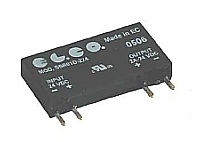Static Relay:
The term ‘static relay’ is generally referred to a relay incorporating solid state components like transistors, diodes, resistors, capacitors, etc. In this type of relay, the functions of comparison and measurement are performed by static circuits wherein there are no moving parts. According to a recent decision of the International Electrotechnical Commission (IEC), which has been adopted by the Indian Standards Institution, the following are the terms relating to static relays.
- Static relay – A relay in which the designed response is developed by electronic, magnetic or other components without mechanical motion.
- Static relay with output contacts – A static relay having a contact in one or more of its output circuit(s). The term previously applied to this type of relay was semistatic relay.
- Static relay without output contacts – A static relay having no contact in its output circuit(s). The term previously applied to this type of relay was fully static relay.
Most present-day static relays, incorporate a hinged armature or a polarized moving coil relay in miniature size as the output device to provide at a low cost a number of output contacts capable of duly tripping. The alternatives are reed relays or thyristors (as indicated in Section 4) which are being considered in recent designs but not yet adopted commercially.
With the growth of power systems in both complexity and fault levels, the need for more sensitive and faster, reliable protection schemes has arisen. The advent of semiconductors overcame the supply problems associated with thermionic valves. The use of transistor amplifiers, etc. deriving their power from an external source, or in some cases self-powered from the current and voltage transformers, made it possible to achieve greater sensitivity and at the same time obtain excellent mechanical stability.
At present protective relays are supplied from iron-cored current transformer and hence excessive saturation should be avoided to ensure high speed and discriminative operation. The use of static relays in general reduces the burden on the current transferers.
One may be surprised to find that static relays have first been commercially produced only in such cases as distance or differential schemes, while in the case of the much simpler overcurrent relay schemes, they have not been brought out. The reason behind this is the fact that distance and differential schemes are more amenable to mathematical analysis while the overcurrent characteristics like those given by the induction disc relays, are more empirical and less mathematical. Thus a static relay cannot compete with the electromechanical standard inverse time overcurrent relay as this characteristic is readily achieved by the saturation characteristics of the electromagnet. On the other hand, the inverse time relay required for overload protection of rectifiers has a characteristic of the form I8t=K which can be achieved with static circuits, but would be extremely difficult to achieve with an induction disc relay. In the field of distance protection, it is possible to derive many varied and complex characteristics with the use of multi-input static comparators. It is possible to accommodate a complete distance scheme in one or two conventional relay cases thus reducing panel space and the cost of interconnecting wiring.
When static relays were first developed availability of components and their reliability were poor. Now these components have attained a record of reliability much better than conventional components. Many thousands of static relays have already been manufactured and used the field experience over the last decade has proved their superiority in more than one sense.
As already mentioned, static relays using thermionic valves could not meet practical requirements and never reached the commercial stage. Rectifier relays, first used in Germany, revolutionized the development of static relays. Transductors offered the advantage of d.c. isolation between control and output circuits. They were widely employed in protective relay applications, but have been discarded due to their slow speed of operation.
Hall effect relays permit instantaneous analogue multiplication of two measured values. However, because of their high cost they have not been used in practical relays. Gauss-effect relays employ semiconductors whose resistance varies when a magnetic field is applied. They are also quite expensive.
Measuring elements of static relays have been successfully and economically built up from diodes, zener diodes, avalanche diodes.The main reason for the rapid progress of transistors into static relays is the instantaneous readiness of operation due to the absence of heaters and their substantially long working life Further, in recent years, the manufacture of components has achieved considerable advances like encapsulation, planner and epitoxial construction techniques, printed circuits, etc. Integrated circuits now occupy a predominant place. These techniques have increased the reliability of the components and reduced the sizes of the modules to small chips.